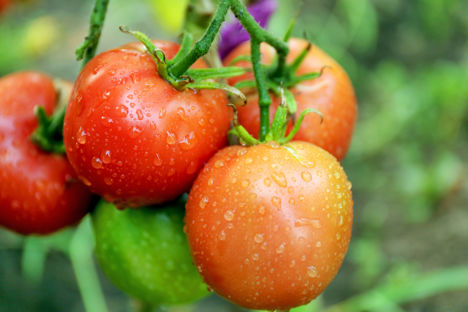
Grow your own: July
Nick Harman gives voice to his weather-related woes, doing everything he can to keep his tomatoes at their best, and harvests the first of his early new potatoes.
View more from this series:
Grow your ownI have no idea whether the sun is belting down outside or it’s raining cats, dogs, and probably dolphins too as you read this. That’s the thing about growing vegetables – the uncertainty of the seasons. If you think it’s bad for us home growers, imagine how farmers feel as they try to work out how much they stand to make or lose on the vagaries of the British weather.
It affects chefs, too, if they rely on local and seasonal, although Ferran Adria once told me (name drop) that he didn’t give a heck where his tomatoes originated as long as they were the best. Even if that meant they’d fly thousands of miles to get to him. Green, he wasn’t.
Well my tomatoes look bad right now but I am hoping the sun of the last few days may give them a renewed lust for life. Tomatoes come in many varieties of course; 3,000 in cultivation and more than 10,000 varieties overall. However, there are only two important things to know; whether yours are bush or cordon types.
Bush tomatoes such as Italian plums can be allowed to grow and sprawl, although it’s best to tie the trusses up to stakes so that the fruits don’t droop into the greedy reach of slugs and snails. Cordon tomatoes such as standard British round tomatoes need to be trained; you’re looking to have one main stem with fruits coming off. To achieve this, you need to be on constant alert for side shoots trying to emerge out of the ‘elbow’ (as you can see in the picture above). As soon as one appears, pinch it out. If you wait too long to do this, then it becomes very hard to see which is the main stem. Too much leafy growth means the tomato doesn’t get round to making fruits until the season is too advanced and they won’t ripen.
When you have three or four fruit trusses, nip off the growing tip of the plant a couple of branches above the topmost truss. The plant will now devote all its energy to swelling and ripening the fruits (hopefully). If it’s dry weather, stick to a regular watering pattern and don’t let the soil dry out. If the plant gets starved of water the tomato skins become tough and then when it rains or you water heavily, the sudden rush of fluid to the fruits makes them swell faster than the skins can stretch and they pop open.
Hold back the blight
And to add to our woes this is blight season (the same blight that caused the potato famine in Ireland; tomatoes are affected by this too). Signs are orange-brown blotches on the leaves and this will eventually spread to the fruits, turning them black and slimy. Pinch off any leaves showing signs to hold back the problem, but if you can get your hands on it, the main defense is a fungicide called Bordeaux mixture.
The EU decided a few years back that as Bordeaux Mixture had never passed their tests it should be taken off shelves until it had. Look for other options in the garden center or try and find somewhere that still has stocks of the real thing. It won’t kill you and it’s been used for a hundred years on tomatoes and spuds; just try not to spray the fruits and if you do, wash it off before eating.
Don’t stop sowing French beans, turnips, beetroots and year-round lettuces over the next few weeks, but you’ll need to keep the seeds well watered if the sun shines for too many days on end. Dig up some first early potatoes, although we’ve got very few so far because of the bad weather. Pick any courgettes to encourage more to form, make sure your nets over cabbages, sweetcorn, kale etc. are secure from the evil pigeons and make sure you weed, weed and weed.

